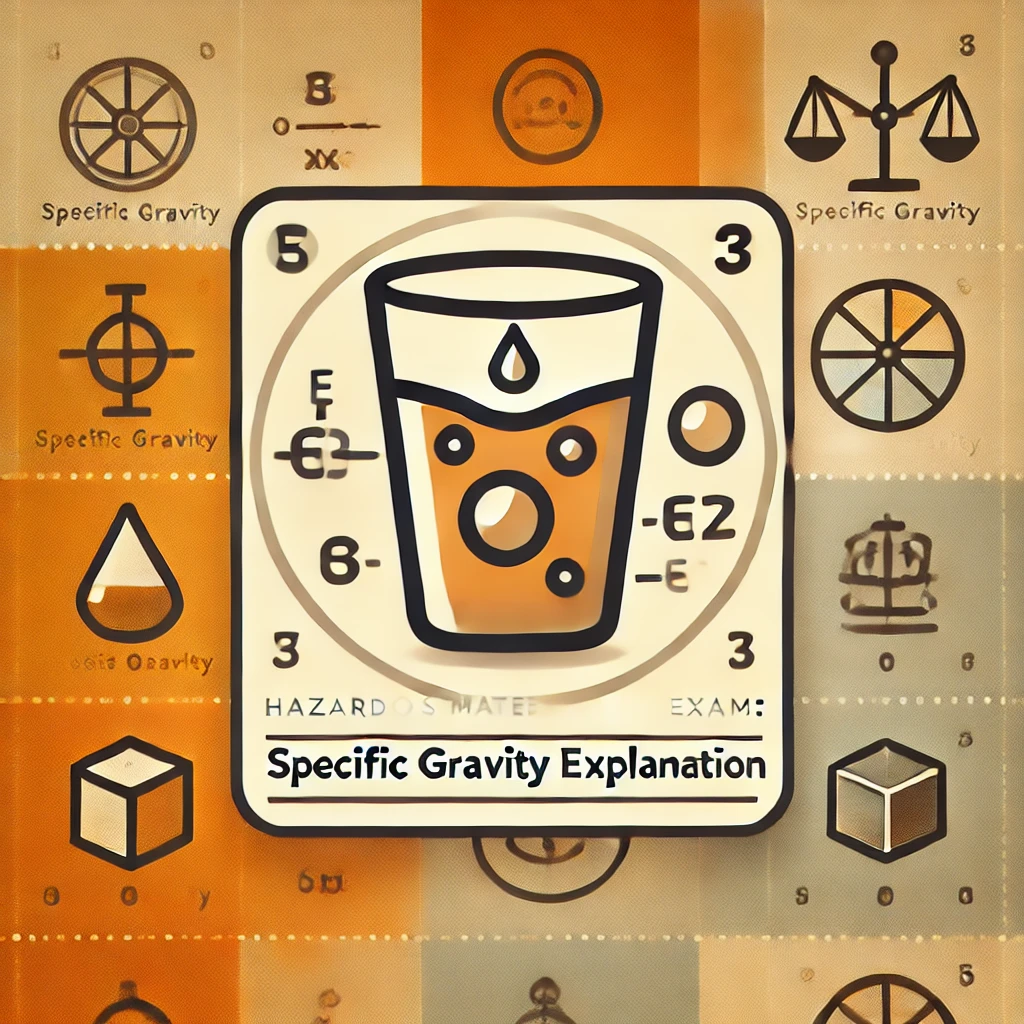Handling hazardous materials requires an understanding of density, specific gravity, and vapor density of the substances. Knowing these concepts helps in understanding the properties and safe handling of materials, forming a foundation for safe operations. This article provides a detailed explanation of these fundamental concepts.
What is Density?
Density represents the mass per unit volume of a substance. Typically expressed in g/cm³, it can be calculated using the following formula:
Formula:
Density = Mass (g) ÷ Volume (cm³)
Examples of Density
For instance, the density of water is 1g/cm³, while iron has a density of approximately 7.8g/cm³, meaning that iron is 7.8 times heavier than water. Substances with higher density feel heavier, while those with lower density feel lighter.
What is Specific Gravity?
Specific gravity is the ratio of the weight of a substance to the weight of an equal volume of pure water at 4°C. It’s a dimensionless value that provides insight into the relative weight of substances.
Formula:
Specific Gravity = Mass (g) ÷ Weight of equal volume of water (g)
Examples of Specific Gravity
For example, the specific gravity of iron is about 7.8, indicating that iron is 7.8 times heavier than the same volume of water. Materials with a specific gravity greater than 1 sink in water, while those less than 1 float.
Vapor Density (Gas Density)
Vapor density represents the relative weight of gases or vapors compared to air, which is assigned a reference value of 1. Gases with vapor densities less than 1 are lighter than air and tend to rise, while those with values equal to or greater than 1 tend to stay near the ground, highlighting the importance of understanding vapor density for gas diffusion and accumulation tendencies.
Calculating Vapor Density
Vapor density can be calculated from a substance’s molecular weight. Using 29 as the average molecular weight of air, vapor density can be calculated as follows:
Formula:
Vapor Density = Molecular Weight ÷ 29
This formula indicates that substances with larger molecular weights also have higher vapor densities.
How to Determine the Average Molecular Weight of Air
According to Avogadro’s law, the weight of 1 mole (22.4L) of air under standard conditions can be calculated. Air is composed of approximately 80% nitrogen and 20% oxygen by volume, with nitrogen having a molecular weight of 28 and oxygen 32, calculated as follows:
– Formula 1: (4 × 28 + 32) ÷ 5 = 28.8 ≈ 29
– Formula 2: (14 × 2 × 0.8) + (16 × 2 × 0.2) = 28.8 ≈ 29
This result indicates that the average molecular weight of air is approximately 29.
Exam Preparation Points
The Hazardous Materials Handler Exam often includes questions on specific gravity, density, and vapor density. Notably, substances with a vapor density greater than 1 are more likely to accumulate near the floor, increasing the fire risk and highlighting the importance of ventilation.
Key Points for Exam
- Specific Gravity and Density Calculations: Memorize the formulas for specific gravity and density and practice calculations.
- Effect of Vapor Density: Understand that substances with vapor densities less than 1 are lighter than air and tend to rise, while those greater than 1 tend to stay near the floor.
- Familiarity with Examples: Remember examples like iron and methane to help reinforce the concepts of specific gravity and density.
Sample Exam Question 1
比重について、次のうち誤っているものはどれか。
(1) 比重とは1気圧4℃のときの純粋な水の重さとの比をいう。
(2) 4℃の水の密度は1g/cm³であり、比重は1である。
(3) 比重が3というのは、同体積の水の3倍の重さがあることを示している。
(4) ガソリンが水に浮くのは、ガソリンの比重が1より小さいからである。
(5) 氷が水に浮くのは、氷の比重が水より大きいからである。
Which of the following statements about specific gravity is incorrect?
(1) Specific gravity refers to the ratio of the weight of a material to the weight of pure water at 4°C.
(2) The density of water at 4°C is 1g/cm³, with a specific gravity of 1.
(3) A specific gravity of 3 indicates that the substance is three times heavier than an equal volume of water.
(4) Gasoline floats on water because its specific gravity is less than 1.
(5) Ice floats on water because its specific gravity is higher than water.
Explanation:
(5) is incorrect. Ice floats on water because its specific gravity is less than that of water. Specific gravity is a relative measure comparing the weight of a substance to an equal volume of pure water at 4°C, making it a dimensionless value. Ice has a specific gravity of about 0.92, which is lighter than water (specific gravity 1), allowing it to float.
Answer: (5)
Sample Exam Question 2
次の物質のうち、空気より軽いものはどれか。
(1) メタン
(2) 酸素
(3) 二酸化炭素
(4) プロパン
Which of the following substances is lighter than air?
(1) Methane
(2) Oxygen
(3) Carbon dioxide
(4) Propane
Explanation:
(1) Methane has a vapor density of 0.55, making it lighter than air. The other options all have higher vapor densities and are heavier than air.
Summary
Density, specific gravity, and vapor density are essential concepts in understanding material properties. By mastering these concepts, one can understand the correct handling procedures and risk management related to fire hazards. For the Hazardous Materials Handler Exam, focus on memorizing the calculation methods for specific gravity and density, as well as relevant examples, to prepare for safe handling of hazardous materials.



コメント